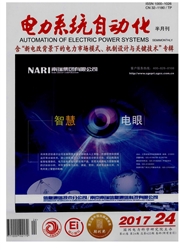

 中文摘要:
中文摘要:
光伏发电或风力发电的选址距配电网一般较远,往往需要通过电缆进行连接。由于电缆的寄生电容较大,使得配电网中的谐波电压在长电缆中出现谐波谐振的问题。在电缆线路终端加入电阻可以有效阻尼电缆上的谐波谐振,且最优的电阻值为电缆的特征阻抗。利用分布式能源并网逆变器,在输出基波有功能量的同时,通过有源谐波电阻的控制策略在连续的谐波频率上模拟纯电阻的特性,可以实现阻尼宽频域谐波谐振的功能。文中首先建立了电缆线路的分布参数模型,并且分析了由于新能源并网接入点电压谐波而引起的电缆线路谐波谐振问题。然后,基于有源谐波电阻的思想,提出一种新的谐波电流指令生成方法,可以实现新能源并网逆变器在连续的谐波频率上呈现纯电阻特性。最后,利用仿真和实验验证了理论分析的正确性及所提出谐波电流控制方式的有效性。
 英文摘要:
英文摘要:
As the siting of photovoltaic or wind power is generally far from the traditional power distribution network,long transmission cables are often needed to transport electric energy.But the cable parasitic capacitance is big,the harmonic voltage in the power distribution network is apt to propagate along the transmission cable.Incorporating a resistor in the cable line terminal can effectively damp harmonic resonance,and the most optimal resistance value is equal to the characteristic impedance of the cable.Except for the fundamental power output,the grid-connected inverter of distributed generator can also be controlled as the pure resistor in continuous harmonic frequency to damp the harmonic resonance in a wide frequency domain.This paper develops the distribution parameter model of transmission cable,and analyzes the cable harmonic resonance caused by the voltage harmonics at the access point of renewable energy.Based on the active harmonic resistor,a new generation method of harmonic current reference is proposed.With the new strategy,the grid-connected inverter can serve as a pure resistor in a continuous harmonic frequency.Finally,the correctness of the theoretical analysis and the effectiveness of the proposed harmonic current control method are verified by simulation and experiment.
 同期刊论文项目
同期刊论文项目
 同项目期刊论文
同项目期刊论文
 A Fundamental Wave Amplitude Prediction Algorithm Based on Fuzzy Neural Network for Harmonic Elimina
A Fundamental Wave Amplitude Prediction Algorithm Based on Fuzzy Neural Network for Harmonic Elimina Novel carrier-based PWM strategy of a three-level NPC voltage source converter without low-frequency
Novel carrier-based PWM strategy of a three-level NPC voltage source converter without low-frequency 期刊信息
期刊信息
